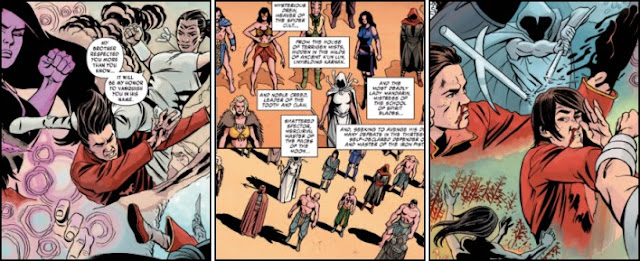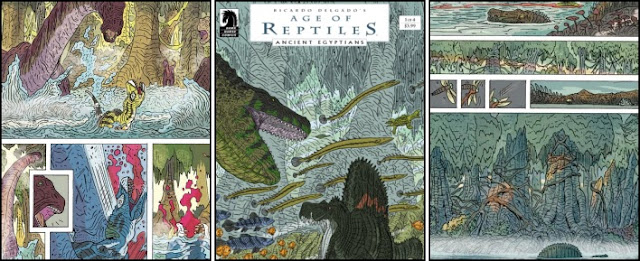 |
| WYTCHES No. 5, March 2015 |
Whilst creator Scott Snyder’s narrative for this
penultimate instalment of “Wytches” is something of a far cry from any work by “The
Master of Suspense” himself, it still contains some wonderfully ‘Alfred
Hitchcock-like’ psychological moments as the title’s main protagonist becomes
increasing paranoid and literally descends into a terrifying all-consuming
madness. Indeed in many ways Charlie Rooks’ utter dismay at his wife’s denial
that they ever had a daughter and realisation that the majority of the
community within which he now lives is somehow part of a coven-based conspiracy
creates some genuinely scary moments.
Equally as disturbing is the American author's ability to
transform his narrative’s local, patient and ever-so friendly policeman, Mister
Petal, into a totally deranged sadistic ‘selfish creature’, who upon
discovering that Sailor’s father knows of his involvement in her abduction, becomes
a seriously chilling guide as to where “these things in the ground” live. Arrogant
and aloof, despite having had his jaw badly busted by Rooks, the sneering cop
continues to disconcertingly inform his captor that the lone parent has
“nowhere to escape to” until Charlie
matter-of-factly shoots the bound, though apparently immortal lawman in the gut.
What follows next however is infinitely more unnerving,
and in places genuinely makes the hairs upon the nape of the neck prickle. For
having covered himself with a jar’s worth of “Stink” and loaded his pistol with
“rat bullets”, due to them having “extra kick”, the determined ‘hero’ climbs
down into the flesh-eating cannibals’ abode and starts to explore its dark
twisting underground passageways in order to 'get his little girl back.'
Sadly such a tense, atmospheric and enthralling horror story is
consistently ruined by the New Yorker frequently interrupting Rooks’
nervy traversal of the Wytches’ warren, with some rather tediously lack-lustre flashbacks to when Charlie’s
wife, Lucy, was first recovering from her automobile accident. These scenes between father and daughter,
brightly lit and dialogue-heavy, horribly jar with the dank gloomy fast-paced
action of the writer's main storyline, and seem to serve no other purpose than
to (once again) demonstrate just how poor a relationship Charlie once had with
Sailor.
Mark “Jock” Simpson’s artwork for these hospital-based
sequences is just as disappointing as their interruptions are welcome, especially
as the Scottish sketcher’s depictions of the quarrelling duo appear rather
robotic and roughly drawn. Fortunately however, the East Kilbride-born
penciller’s illustrations of Rooks grimly stalking the tunnels of the
ghoul-faced “chit chit” anthropophagi are worryingly wonderful and there’s a
real sense of menace about the bulbous-eyed skull-like creatures whenever they
appear; “That’s
right… they’re smelling you aren’t they? Yes, they are.”
 |
| Story: Scott Snyder, Art: Jock, and Colors: Matt Hollingsworth |


































